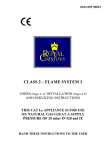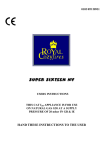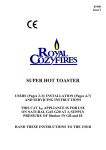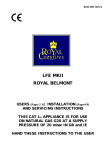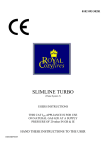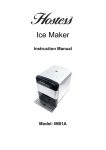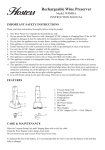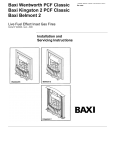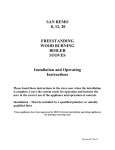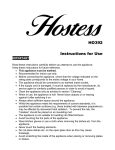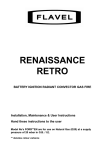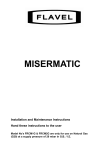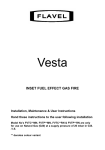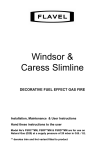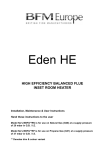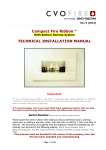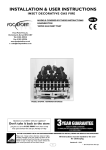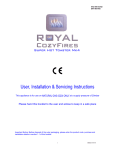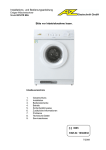Download Royal Consumer Information Products U19019 G20 User's Manual
Transcript
81139 Issue 3 52<$/&+(/7(1+$0 USERS INSTRUCTIONS THIS CAT I2H APPLIANCE IS FOR USE ON NATURAL GAS G20 AT A SUPPLY PRESSURE OF 20 mbar GB and IE HAND THESE INSTRUCTIONS TO THE USER DESCRIPTION The Royal Cheltenham glass fronted high efficiency live fuel effect inset gas fire has been developed from the successful Royal Cozyfires LFE using much of the technology and components used in the manufacture of this appliance. The fuel bed has a realistic coal effect utilizing ceramic ‘coals’ and coal bed that allows secondary air to be entrained into the bed for clean combustion. The burner is an aerated twin ported steel burner running parallel across the front of the fire. The gas control fitted has a variable high to low setting and includes the added protection of a flame supervision device. A separate piezo igniter used to ignite an Oxy/pilot device to prevent continued spillage occurring under hazardous flue conditions. The installation must be carried out by a competent person in accordance with the relevant British Standards, Codes of Practice and Gas Safety (Installation and Use) Regulations 1994 or the rules in force. Failure to install an appliance correctly could lead to prosecution. Before the appliance is installed, the installer must check that all the requirements for the flue are satisfied and that the chimney is sound and clean, and that it has been swept prior to installation. IMPORTANT NOTES FIREGUARD The glass window on this gas fire is manufactured to the requirements of BS 1945 1971, and satisfies the Heating Appliances (fireguards) (safety) Regulations 1991. The Royal Cheltenham is a heating appliance and as such some areas of the appliance will become hot. It is recommended that a fireguard to BS 6539 1984, is used for the protection of young children, the elderly and the infirm. THIS APPLIANCE IS FITTED WITH SPECIAL HEAT RESISTING GLASS PANELS, IF ANY PANEL IS DAMAGED THE FIRE MUST NOT BE USED AND A REPLACEMENT SPARE PANEL MUST BE OBTAINED TO CARRY OUT THE REPAIR. It is very important that the warm air outlet grilles are not obstructed or used for drying towels etc. When the fire is new, an initial odour may be detected. This is due to certain materials used during the manufacture of the fibre components, increase the ventilation to the room during the initial burn-in. The stainless steel used for the construction of the combustion chamber may become discoloured (blued). This is due to the temperatures and does not detract from the effectiveness of the fire. This product uses fuel effect pieces, gaskets and insulation material containing Refractory Ceramic Fibre (RCF), which are man-made vitreous silicate fibres. Excessive exposure to these materials may cause temporary irritation to eyes, skin and respiratory tract, consequently, it makes sense to take care when handling these articles to ensure that the release of dust is kept to a minimum. Care must be taken on the selection of the wall coverings within close proximity of the fire as some vinyl’s and embossed materials may become discoloured by convected heat. Soft furnishings must be kept clear from the radiant heat of the fire and from impinging the hearth area. The hearth must not be covered by any combustible materials such as carpet, etc. It is recommended that the appliance is serviced annually by a competent person, the flue checked for satisfactory clearance of combustion products and that there is no excessive build-up of soot. An inspection should be made for any build-up of soot or debris falling behind the unit that could prevent products of combustion being drawn into the flue. Any existing or purpose built ventilation must be kept clear and free from obstruction. Page 2 TECHNICAL DATA Heats Input Rates: High Setting Low Setting 5.42 kW 2.34 kW 18,500 Btu/h (Gross) 8,000 Btu/h This fire will run for 5.4 hours on one therm of gas on high setting. LOCATION OF COMBUSTIBLE SHELVES ABOVE FIRE SIDE OF FIRE Min. Height of 150mm deep shelf above hearth = 830mm Min. Dimension from outer edge of fire to a combustible surface of 150mm depth is 100mm. When the shelf depth is increased by increments of 12.5mm, add 25mm to the height above fire. TO LIGHT APPLIANCE (see Fig 1) Remove the Fret (controls cover) to gain access. Press and turn the gas control knob anticlockwise until the indicator is opposite IGN. Keep the gas control fully depressed. Press and release the igniter button until the Oxy/pilot flame situated on the left-hand side of the burner has lit. Keep the gas control depressed for a further 10 to 15 seconds. Release the gas control and check that the pilot flame remains lit. Refer to Fig 3 to view pilot. Note. For convenience, the unit can be operated with the pilot only, e.g. with the control knob set in the IGN position. Push in the gas control slightly and turn anticlockwise so that the indicator dot is at the required setting. Replace the Fret (controls cover). To turn off the appliance and pilot, turn the gas control clockwise from any position - until the indicator dot is opposite OFF. In the event of the piezo igniter failing, the fire can be lit with a taper or spill. Light the taper and push through the slots below the glass panel in the position shown in fig 2. Push and turn the control knob to the ignition position and keep it pressed for 10 seconds after the Oxy/pilot has lit. IMPORTANT: After turning the appliance OFF, allow 3 minutes before attempting to relight. Should the Oxy/pilot flame become extinguished and cut off the gas supply to the main burner, allow 3 minutes before attempting to relight, if this re-occurs turn off the appliance and seek expert advice. Page 3 DISMANTLING THE FIRE BED FOR CLEANING (see fig.3, 4 & 5) Allow the appliance to cool for 1 hour before handling any components. Remove the controls cover and unscrew the two wing screws securing the canopy in place as shown in (fig 3). Lift the canopy off the appliance and place to one side. Support the glass panel and remove the four wing screws securing the glass panel and retaining plate in position and lift clear of the L & R hand corner retaining brackets and upwards clear of the side plates. Should any soot accumulation become excessive, the fuel effect pieces should be removed from the fire for cleaning. Cleaning should be carried out in a well-ventilated area or in the open air, by gently brushing with the pieces held away from your face so that you avoid inhaling the dust. We do not recommend the use of a normal domestic vacuum cleaner, which may blow dust back into the air. Care fully lift off the coals and the coal support shelf, remove the L & R hand side cheeks also the simulated coal front, lift out the two burner inserts, if necessary remove the back panel. Any debris in the burner ports may be removed with a thin piece of card or similar material. The firebed can now be replaced in the following way. If the back panel has been removed - stand the panel on the support flange behind the two rear legs and stand the L & R hand side cheeks on the side support flanges. Place the coal support shelf with the rebate on the underside, located over the rear flange of the support channel. Place the burner inserts in the channel between the front and rear ports; position the simulated front coal on the shelf with the rebates over the flanges. See Fig 4. Page 4 COAL LAYING INSTRUCTIONS Lay the four front coals diagonally with the stepped corner sitting on the simulated coal front and the small corner notch at the rear. Lay a further row of four coals behind the front row with stepped corners in the rear corners of the front row, the two centre coals having notches in the rear top corners. Lay two more coals in the notches of the centre two coals. See Fig 5. Lay the three small coals on the top L&R corners and in the centre of the back row. Page 5 Note: Should any ‘coals’ or the coal bed become damaged, lost or broken, only the correct replacements must be obtained and fitted before the appliance is used. Extra ‘coals’ etc. must not be added to the coal bed. The coal bed must always be assembled as detailed. This appliance is fitted with an Oxy/pilot the purpose of which is to monitor spillage in the event of a flue blockage or hazardous flue condition. This may cause the oxygen content of the room to become depleted; the flame then becomes extended which allows the thermocouple to cool sufficient to cause the FFD to cut off the supply of gas to the burner. If this occurrence is repeated, the appliance must not be used until a specialist has been consulted. CLEANING THE FRONT OF THE APPLIANCE AND CLEANING THE WINDOW The fire must be turned off and allowed to cool for approximately 2 hours. The paintwork should be cleaned with a soft cloth or soapy water. The brass trim can be cleaned with most proprietary brands of metal cleaners although care must be taken not to use abrasive materials. The glass window can be cleaned with most proprietary window cleaners. To clean the coal bed or the inside of the glass panel refer to 5.1 & 5.2 SPARES AND SERVICE For spares and service, apply to your local Supplier, Installer or direct to the manufacturer, stating that the appliance is a Royal Cheltenhan. Quote the GC Appliance Number and the Serial Number from the Data Badge located on the front control panel. Advantage should be taken of regular servicing and inspection of gas appliances to ensure their continued safe operation. SHORT PARTS LIST Description Qty Crosslee Pt No Complete coal & fibre pack 1 42203 Page 6 GC No REGISTRATION RECORD Purchaser’s Name __________________________________________________ and Address __________________________________________________ __________________________________________________ Supplier’s Name __________________________________________________ and Address __________________________________________________ _________________________________________________ Installer’s name __________________________________________________ and Address __________________________________________________ __________________________________________________ Date of Purchase __________________________________________________ Serial Number __________________________________________________ MAX HEAT INPUT 5.42kW 18500 Btu/h (Gross) Royal Cozyfires are manufactured by: CROSSLEE plc Aber Park Industrial Estate, Aber Road, Flint, Flintshire. CH6 5EX Spares Tel 01422 203963 Fax: 01422 204475 Service (GSA Ltd.) 01703 516611 Customer Service 01422 200660 Fax 01422 206304 *Technical Help Line 0906 8633268 *Calls charged at 50p per minute age 7 81140 Issue 3 52<$/&+(/7(1+$0 INSTALLATION AND SERVICING INSTRUCTIONS THIS CAT I2H APPLIANCE IS FOR USE ON NATURAL GAS G20 AT A SUPPLY PRESSURE OF 20 mbar GB and IE HAND THESE INSTRUCTIONS TO THE USER DESCRIPTION The Royal Cheltenham glass fronted high efficiency live fuel effect inset gas fire has been developed from the successful Royal Cozyfires. The fuel bed has a realistic coal effect utilising ceramic ‘coals’ and coal bed that allows secondary air to be entrained into the bed for clean combustion, the burner is an aerated twin ported steel burner running parallel across the front of the fire. A gas control with a variable high to low setting with a separate piezo igniter is used to ignite a Oxypilot device to prevent continued spillage occurring under hazardous flue conditions with the protection of a flame supervision device. The fire is suitable for use in conjunction with 228mm x 228mm (9" x 9")(Class 1) flues, 125mm (5") diameter twin walled metal flues (Class 2) and properly constructed pre-cast flues to BS 1289 PT1 1986 & 1975. A spacer frame is supplied to assist with the installation into pre-cast flues or where a reduced depth is available. The installation must always be used in conjunction with a suitable hearth and surround (refer to fig 1 for further details). IMPORTANT NOTES Areas of this appliance will become hot after prolonged running and it is recommended that for the protection of the very young, elderly and infirm a fireguard conforming to BS 6539 or BS 6778 be used. Additional purpose built ventilation is not required for this appliance in GB only, for IE ventilation is required with a minimum cross sectional area of 100 sq. cms and should be checked regularly to ensure that it is free from obstruction. Care should be taken to prevent any damage being caused to surrounding soft furnishings or decor e.g. many embossed vinyl wall coverings may become discoloured if located too close to the appliance. Clearances required for combustible shelves are shown on page 4. This product uses fuel effect pieces, gaskets and insulation material containing Refractory Ceramic Fibre (RCF), which are man-made vitreous silicate fibres. Excessive exposure to these materials may cause temporary irritation to eyes, skin and respiratory tract, consequently, it makes sense to take care when handling these articles to ensure that the release of dust is kept to a minimum. A hearth must always be provided to project forwards of the back panel a minimum of 300mm and a minimum of 150mm either side of the fire opening. The hearth must be a minimum thickness of 12mm with a perimeter height of 50mm, to discourage placing carpets or combustible materials close to the fire. The area under the appliance must have a minimum non-combustible thickness of 25mm. In most installations a back panel will be required, this must be either non-combustible or have a minimum fire resistance rating of Class o O (100 C). The glass front is manufactured from three separate panels, when the appliance is cold a small gap may appear between the joints, this is normal and does not impede the function of the appliance. The brass trims are covered with a protective polycoat that must be removed prior to lighting the appliance. TECHNICAL DATA Overall height of fire = 620mm Overall width = 660mm Overall depth (Forward of plane of opening) = 180mm Overall depth with spacer (Forward of plane of opening) = 230mm Minimum height of opening see fig 1= 560mm Minimum width of opening see fig 1 = 400mm Minimum depth of opening see fig 1 = 220mm Minimum depth with spacer = 17Omm Type of gas Natural Gas only (G20) Setting pressure 20mbar +/- 1mbar (cold) Heat Inputs Max Min Pilot Main Injector types 5.42kW (18500 Btu/h) 2.34kW (8000 Btu/h) 0.26kW (890 Btu/h) Bray 82/380 Stereomatic Size 68 Pilot Assembly E.A.S.D Oxypilot NG 9O22 Gas Connector8mm O/D Tube Weight 26.7Kgs Page 2 INSTALLATION REGULATIONS AND REQUIREMENTS In the interests of both the Law and of Safety, this appliance must only be installed by a competent person in accordance with the current Gas Safety (Installation and Use) Regulations or the rules in force and the manufacturer’s instructions. Note: Failure to install a gas appliance correctly could lead to prosecution. The following are the relevant Codes of Practice and British Standards. The Building Regulations issued by the Department of the Environment. The Building Standards (Scotland)(Consolidation) Regulations issued by the Scottish Development Department. BS 83O3 1986 BS 1251 1987 BS 6891 1988 BS 715 1993 BS 544O Pt1 199O BS 5871 Pt2 1991 BS 6461 Pt1 1984 BS 1289 Pt1 1986 & 1975 BS 544O Pt2 1989 BS 7566 Pt 1-4 1992 FIRE SURROUND AND OPENING REQUIREMENTS Check that the chimney and flue structure are sound and conform to the following flue requirements: a) A conventional brick or stone chimney with a minimum effective cross-sectional dimension of 228mm x 228mm, a lined flue with a minimum diameter of 175mm, a minimum effective height of 3m and having a chairbrick and throat forming lintel conforming to BS 1251 or a builders opening measuring 540mm high x 400mm wide with a sufficient volume for debris collection. If a chairbrick is fitted, a minimum depth requirement for the fire with the spacer fitted is shown in fig 1 - if insufficient space is available the chairbrick will have to be removed. b) A twin walled metal flue box manufactured to BS 715 with a 125mm diameter insulated flue with a minimum effective height of 3 metres. See page 6. c) A pre-cast flue conforming to the requirements of BS 1289 Pt 1 1986 including properly constructed pre-cast flues (formerly BS 1289 1975) with a cross sectional area of 13000sq mm. Dampers, register plates or incorrect flue terminals, must not restrict any of the above flues. The flue must only service a single appliance and not have any branches or traps which may impede the natural draught, any flue damper or restrictor must be removed or fixed in the fully open position. The front and base of the fire opening must be flat and square to ensure a good seal with the appliance; this is to ensure that there is no reduction in draught that may cause spillage to occur. CONTENTS CHECK LIST Fire Box Assembly c/w Burner Assembly Glass Panel Flue Restrictor Blanking Plate & Gasket Ceramic Components Fibre Back panel L & R Hand Side Cheeks Simulated Coal front Coal Support Shelf 10 Large Coals 3 Small Coals Components Fender Ash Pan Cover L & R Hand Side Covers Canopy Spacer Frame Fixing Kit 6 Plastic Wall Plugs 4 No 10 x 1 1/4" Round Hd Woodscrews 4 U-Spring Clips 2 No 8 x 1" Round Hd Woodscrews 2 No 8 x 1/2" Self Tap Screws 2 Penny Washers 4 M4 x 12 Pan Hd Machine Screws 1 8mm Equal End Coupling 2 M4 Wing Screws 1 Cable Fixing Kit Bundy Pipe for Concealed Fitting Bundy Pipe for RH Gas Supply 8mm x 8mm Inline Connector Installation & Servicing Instructions Users Instructions Brass Knob Kit Page 3 Clearance to side (timber surrounds etc.) Minimum clearance required to any combustible material to the side of the appliance must be 150mm. Clearance to shelves. Minimum clearances to undersides of a 150mm deep combustible shelf from the hearth must be 830mm. Add 12.5mm to this clearance for every 25mm increase in depth of shelf. Page 4 Page 5 INSTALLATION USING A 5" DIAMETER METAL FLUE BOX Important: The Flue restrictor plate must be removed see Fig 10. When the metal flue box is to be built-in as a false chimneybreast using timber stud work with plasterboard facing, the flue box should be enveloped with insulation material such as rockwool or similar to prevent a build up of heat within the structure. An air gap of 75mm should be maintained between any combustible materials and any part of the flue box or 25mm of insulation between the flue box and the combustible material. It is important that both the back panel and the appliance are sealed to the gas flue to prevent any leakage of flue products, or reduction in the flue draught. Page 6 INSTALLATION OF THE APPLIANCE Check that the chimney conforms to the required specifications as previously stated. Examine the condition and carry out any remedial work, if the flue has been used for solid fuel it should be swept and a smoke test carried out to check that satisfactory smoke clearance has been established. If all the smoke is not drawn into the flue, pre-heat the flue with a blowtorch or similar and re-check. If there is any uncertainty examine for the cause and if necessary seek expert advice. GAS SUPPLY BEFORE COMMENCING WORK TURN OFF ANY APPLIANCES THAT ARE FED BY THE METER AND ISOLATE THE GAS SUPPLY BY TURNING OFF AT THE METER The gas connection to this appliance is made with 8mm o/d rigid or semi-rigid tube to a pressure test elbow situated on the L/H side of the burner as shown in fig 14. It is advisable to provide a means of isolating the gas supply to the appliance for servicing with either a restrictor elbow or isolation cock such as shown in fig 18. Provision is made for the gas supply to enter in the rear left corner, using a blanking plate and gasket, to enable a seal to be made around the tube see fig 11. Any tube used under the burner must be rigid or semi-rigid tube such as bundy, formed sections are provided which may be used to connect to 8mm copper using the inline connector supplied. Copper o tube must not be used under the burner to avoid exceeding the maximum 100 C temperature permissible for copper tube. Alternately the supply may be routed from either the left or right hand side of the appliance as shown in fig 12. Where a connection is to be made direct to the control valve, the support pipe bracket can be removed by unscrewing the control mounting lock nut and sliding the bracket over the control spindle and re-tightening the lock nut. Where a concealed gas supply is used, the installer is reminded of the requirements of BS 6891 1988 dealing with enclosed pipes. The Standard requires that when a gas pipe is fed through a wall, the pipe should be enclosed in a tight sleeve to protect against failure caused by movement and shall be constructed to prevent passage of gas either between the pipe and sleeve or sleeve and wall. DISMANTLING THE APPLIANCE PRIOR TO INSTALLATION Carefully remove the front glass panel, held in position with 4 x winged thumbscrews and a retaining strip. Ensure care is taken to support the glass panel while removing the screws and then lift the glass panel clear of the retaining brackets in the bottom L&R hand corners. In most instances it will be necessary to remove the burner to gain access for a concealed gas supply. Remove the two screws securing the burner in position, lift and pull the burner assembly forward observing the two tags locating the rear legs in position. If a concealed gas supply is to be used remove the blanking plate and gasket from the rear L hand corner. INSTALLING THE APPLIANCE IN POSITION When the gas supply pipe has been laid in the required position and the surround and hearth has been fitted correctly and sealed to the chimney to prevent seepage of flue products from the flue, precautions should be taken to protect any polished surfaces from scratches or damage. The installation should be checked for gas soundness prior to fitting the appliance. Two options are provided that should enable the appliance to be secured in position, both of these require that every precaution be taken to ensure that a good seal exists between the appliance and the flue. OPTION a) Is to secure the appliance to the back panel/surround through the 4 holes provided around the rear frame of the appliance. a (i) If a spacer frame is not required, remove either the screws and captive nuts blanking off the fixing holes or, remove the (semi-sheared) knock-out holes, dependant on manufacturing methods used. Place the fire in the required position, spot and drill through the fixing holes for the plastic fixing plugs supplied and secure in place in the positions shown in fig 6. Page 7 a (ii) If the spacer frame is to be used, attach the frame to the rear of the appliance using either the screws and captive nuts removed from the appliance or supplied in the fixing kit, see fig 8. Place the fire in the required position; mark around the perimeter of the spacer frame remove the appliance and the spacer frame from the appliance. Position the spacer frame to line up with the markings, spot and drill through the wall fixing holes in the positions shown in fig 7, and secure in position using the screws and plastic fixing plugs provided, refit the appliance to the spacer frame. OPTION (b) Is to secure the appliance to the opening using a wire bond as shown in fig 9. b(i) Without a spacer frame fitted. To use this method a min depth of the opening of 220mm is recommended to allow a uniform pull on the wire bond. In addition to this method it may require the base of the appliance to be secured to the hearth to prevent any movement taking place. Three knock-out blanks are provided in the base for this purpose although one central fixing should be sufficient. To establish the correct location, place the appliance in the opening and knock out the appropriate blank. Mark around the hole, remove the appliance - spot and drill hole a central of the mark suitable for the fixing plus provided. Drill and plug with the plastic fixing plugs provided to the rear of the opening or chairbrick in the position shown in fig 9, Screw in the two screw eyes securely. Remove the two clamp bolts from the rear panel of the appliance and thread the wire bond through the two slots in the spigot flange. Place the fire in front of the opening allowing sufficient room to loop the ends of the bond through the screw eyes and back through the bottom dimpled holes in the back panel. Push the fire back into the opening, thread the wire through the washers and adjusting screws, turn the lock-nuts back to allow sufficient adjustment and fit the clamp bolt with the lock-nut and washer, turning the lock nuts on the adjusting screws to tighten the cable. Secure the base of the appliance using a No 8 x 1" screw and penny washer provided. Do not cut the wire bond; coil the excess to ensure sufficient length of wire is available so the appliance can be removed for servicing or debris removal. b (ii) With spacer frame fitted. The spacer frame must be fitted to the rear of the appliance which will require either the removal of the screws and captive nuts from the fixing holes in the frame of the appliance or the knock-out blanks (semi-sheared) holes. Assemble to the spacer with the self-tap screws and captive nuts fitted to the spacer as shown in figure 7. Locate and secure the appliance by the method chosen ensuring that a good seal exists with the Hearth and Back panel. Connect the gas supply to the location of the Burner Connecting elbow and place the burner in position with the feet of the rear legs located in the two tags of the base plate. Secure the Burner in position with the 2 x No 8 Self-tap screws provided and complete the gas connection. Check the installation for gas soundness. LAYING THE FIRE BED Position the rear fibre panel on the stepped flange of the burner assy as shown in fig 14. Stand the L&R hand side cheeks upright - place the coal support shelf on the channel provided assuring that the rebate on the underside of the shelf locates over the flange of the support channel. (The 4 lugs offer a secondary support to maintain a sufficient gap between the front of shelf and the rear of the burner inserts). Position the two burner inserts in the channel between the two burner ports. Position the simulated front coal on the shelf with the two upturned flanges in the rebates in the underside of the moulding. COAL LAY-OUT Lay the four front coals diagonally with the stepped corner sitting on the simulated coal front and the small corner notch at the rear. Lay a further row of 4 coals behind the front row with the stepped corners resting in the notches in the rear corners of the front row, the two centre coals having notches in the rear top corners. Lay 2 more coals in the notches of the centre two coals - Fig 13. Lay the three small coals on the top L&R hand corners and in the centre of the back row.Locate the glass panel with the bottom two corners locating in the retaining brackets and secured at the top with the retaining strip and the 4 x M4 Wing screws. Locate the L&R hand side covers with the 4 x M4 screws provided, sufficient to allow the covers to slide up and down, see fig 15. Page 8 Page 9 Page 10 Page 11 Page 12 CHECKING OPERATION OF FIRE Purge the air from the appliance by rotating the control to the ignition position, push the control to allow the air in the pipework to be purged, push the piezo to ignite the Oxy/pilot. Check that the electrode is sparking between the tip of the thermocouple and continue until a pilot flame has been established. Depress the control knob slightly and rotate anti-clockwise until the index symbol is aligned with the small flame symbol on the indicator label, release and allow the appliance to run for a period of 2 minutes. Prior to carrying out the spillage test, rotate the control knob to the high position (large flame symbol) and check that the flame picture is satisfactory, i.e. the gas rate increases and is evenly spread. Turn off the appliance and allow the coals to cool, connect a manometer to the pressure test point at the inlet elbow, turn the gas on and check for gas soundness. Re-light the fire and check for the correct inlet pressure (i.e. 20mbar +/-1mbar) and refit the pressure test point screw. Turn the gas control to the OFF position, wait for 90 seconds, fully depress the gas control, turn to ignition position and release the control. Attempt to light the pilot with an already prepared match or taper. If the pilot ignites it would indicate the FSD is faulty - the gas valve must be changed. SPILLAGE CHECK The spillage check must be carried out with the Controls Cover, Fender and Canopy removed. Light the appliance and set to the (max) large flame position and leave to warm up for 5 minutes. Check for satisfactory clearance of combustion products by inserting a smoke match 10mm down from the top of the cut-out in the R hand side of the front coal moulding as shown in fig 17. All the smoke must be drawn into the flue. If spillage occurs, allow a further 10 minutes. Should spillage still occur, examine the chimney for the fault and rectify. The test should be repeated if an extractor fan is situated in the room. If there is a connected room, the test should be repeated with all the doors in that room opened. If there is still any evidence of spillage then there is a fault with the chimney. Disconnect the fire and seek advice from an expert. Position the wrap around fender with the L&R hand ends located in the slots in the side covers and secure at the front with two screws viewed through the front aperture, tighten the top two screws of the side covers. Slide the canopy down over the top of the appliance with the top flange of the canopy behind the top lip of the appliance. Align the fixing holes under the L&R hand sides of the canopy with those in the side covers and secure with the two wing screws provided, see figs 15 & 16. Demonstrate the lighting and extinguishing procedures to the user and place the controls cover in front of the appliance. ADVISE THAT: The curing effect of heating the coals will cause an initial odour. The appliance is fitted with an Oxy/pilot to monitor spillage of products into the room. If there is a spillage of products into the room the pilot flame will lift causing the FFD to shut off the gas supply to the appliance, should this occur it will not be possible to re-light the pilot flame until a normal air supply has been established. If this occurrence is repeated the Flue and the appliance must be examined and the fault rectified. Any debris or soot is cleaned from the appliance. Advise the customer that they should read their Users Instructions before operating the fire and always follow the advice in the section headed ‘Removal of Debris or Soot Deposits’. The appliance must be serviced annually by a competent person in accordance with these instructions and the appliance is checked for spillage in accordance with the method detailed in these instructions. The canopy and glass front panel can be removed for cleaning purposes as follows: Remove the two wing bolts under the rear edges of the canopy and lift off the canopy - Fig 16. Remove the four wing bolts securing the glass front panel top fixing bracket and lift the glass panel assembly vertically out of the bottom retaining brackets and decorative side panels. The glass panel can be cleaned with a proprietary glass cleaner. Replace the glass panel in reverse order of removal ensuring a panel is correctly located in the bottom retaining brackets. Page 13 Complete the registration section at the end of this booklet. Advise that any component part of this appliance be guaranteed against defective workmanship or faulty materials for a period of twelve months from the date of purchase. Any such part will be replaced free of charge on receipt of the purchaser’s address at the cost of postage only, provided that: a. It is accompanied by the registration section cut out of the booklet, together with the original purchase receipt, which will be returned with the replacement part. b. Any installation, repairs or adjustments have been carried out by a competent person, such as the supplier’s representative or a CORGI registered installer MAINTENANCE AND SERVICING - GENERAL IMPORTANT. The fire should be removed from the surround to check and clear the area behind the fire for build up of debris on every service visit. Remove the outer decorative panels and glass front as detailed previously and place in a safe position. ALWAYS CHECK FOR GAS SOUNDNESS AFTER EVERY SERVICE AND/OR PART EXCHANGE REMOVAL OF DEBRIS or SOOT DEPOSIT A. Allow the appliance to cool for two or three hours before removing all of the coals and ceramic components for cleaning purposes. Once all the ceramics are removed from the firebed check that no debris is located in the burner slots (ports). If any debris is present it may easily be removed by using a small piece of thin cardboard to ease out any foreign matter. Be sure to remove the cardboard after use. Any sooty deposits or debris formed on the coals may be removed by using a soft brush. To ensure that the release of fibres from these RCF articles is kept to a minimum, during installation and servicing we recommend that you use a HEPA filtered vacuum to remove any dust and soot accumulated in and around the fire before and after working on the fire. When replacing these articles we recommend that the replaced items are not broken up, but are sealed within heavy duty polythene bags, clearly labelled as RCF waste. This is not classified as "hazardous waste" and may be disposed of at a tipping site licensed for the disposal of industrial waste. Protective clothing is not required when handling these articles, but we recommend you follow the normal hygiene rules of not smoking, eating or drinking in the work area and always wash your hands before eating or drinking. Any sooty deposit on the thermocouple probe can be cleaned of using a non-fluffy cloth. Replacement is in reverse order. NOTES: TURN OFF THE APPLIANCE AT THE SERVICE COCKS. DO NOT USE ABRASIVE MATERIALS B. SERVICING COMPONENTS BELOW THE BURNER ASSEMBLY: Remove Glass front and fender, coals, coal supports, burner inserts and front simulated coal. To gain access to components below the burner assembly it has to be removed from the case by disconnecting the gas supply at the inlet elbow and unscrewing the two screws at the base of the fascia panel. i) TO CLEAN OR REPLACE THE INJECTOR: Unscrew the compression nut connecting the gas supply to the elbow injector while supporting the injector to prevent distortion of the framework. Unscrew and remove the gas supply tube from the gas control valve, hold the injector lock nut with a spanner and rotate the injector. Replace in reverse order. ii) TO REPLACE THE GAS CONTROL (Tap/FSD): Disconnect the three gas pipes and the thermocouple from the control. Pull off the knob and lay to one side. Undo the retaining nut at the front of the tap niting assembly to withdraw control from the mounting bracket. Replace in reverse order. iii) TO REPLACE THE PIEZO IGNITER: Pull off the HT lead from the rear of the igniter. Retain the metal fixing nut with one finger and rotate the body of the igniter to unscrew. Withdraw the igniter from the front. Replace in reverse order and reconnect the HT lead. iv) OXY/PILOT ASSEMBLY: The assembly is not a serviceable item as part of its calibration depends upon the proximity of the spark electrode and thermocouple tip. The assembly can be replaced by removing the tube nut and tube from the base of the pilot and the thermocouple from the FFD also the igniter lead and the two M4 screws securing the bracket to the framework. Replace in the reverse order. The spark gap is shown in fig 18. Page 14 Page 15 SHORT PARTS LIST For spares contact the manufacturer at the address overleaf. DESCRIPTION CROSSLEE No GC No Piezo Igniter Control Knob Control Valve Oxy/Pilot Burner Assembly Main Injector Complete Coal & Fibre Pack 40245 40232 42143 42313 42168 42203 397 686 170 014 378 092 170 415 378 090 REGISTRATION RECORD Purchaser’s Name and Address ……………………………….......................................... …………………………….............................................. …………………….......................................................... …………………….......................................................... Supplier's Name and address ……………………………….......................................... …………………………….............................................. ……………………........................................................... ……………………........................................................... Installer's Name and Address ………………………………........................................... ……………………………............................................... ……………………........................................................... ……………………........................................................... Date of Purchase .............………. Serial Number ……….............. Please return this section with any components that are faulty under guarantee. MAX HEAT INPUT 5.42kW 18500 Btu/h (Gross) Royal Cozyfires are manufactured by: CROSSLEE plc Aber Park Industrial Estate, Aber Road, Flint, Flintshire. CH6 5EX Spares Tel 01422 203963 Fax: 01422 204475 Service (GSA Ltd.) 01703 516611 Customer Service 01422 200660 Fax 01422 206304 *Technical Help Line 0906 8633268 *Calls charged at 50p per minute
























